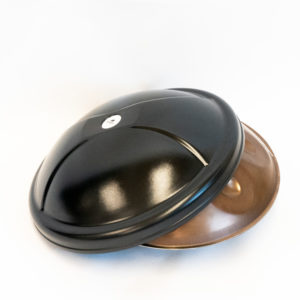An extraordinary musical instrument

An Introduction to the History of the Handpan
The handpan is an extraordinary musical instrument. The handpan draws its inspiration from the steel drum of Trinidad and Tobago and the ghatam of India. Crafted with specially hardened steel, the handpan produces a powerful resonance with numerous overtones. This unique sound can transport the listener or player into a meditative state.
The term “handpan” was first used in 2007, with Pantheon Steel being one of the early manufacturers to adopt the name. It emerged as a spiritual successor to the Hang®, which originated in Switzerland around the year 2000. Since the name “Hang®” is a registered trademark of PANart, it was necessary to find a generic name for the instrument. Since then, instrument makers from around the world have embarked on developing this magical and captivating instrument. It is the unique history of the handpan and the thriving community that has formed around it that adds to the mystique of the handpan. Today, there are hundreds of instrument builders worldwide. Therefore the development of the instrument is far from complete, with constant exploration of new techniques, materials, and electronic adaptations of its sound.
What does the Opsilon handpan sound like?
Here is an audio sample:
The History of Handpan
But what makes the handpan so special? The handpan is a melodic-percussive instrument played with the hands and ideally placed on the player’s lap. Rhythm and harmony merge in the handpan, creating a sensitive and intuitive instrument. Additionally this unique sound offers a wide range of over 30 different scales with different variations.
Each standard handpan has 8-9 notes combined with one note in the middle of the top side of the instrument, the so called Ding. Besides this, each scale has its own timbre, allowing the player to individually and playfully explore the instrument’s sonic dimensions. Due to its melodic-percussive nature, the handpan appeals to both percussionists and players of melodic instruments. It is beginner-friendly and offers a sense of achievement for musicians at any level.
With a weight of only about 5 kg and easy portability, the handpan is also suitable for travelers and street musicians. Therefore travelling with the handpan is something instrinsic if you play this instrument.
The handpan can be used as an accompaniment for various meditations and sound therapy practices, as well as a traditional instrument in music production.
But let’s go back to the basics:
What is a steel drum?
The steel drum is a percussion instrument and belongs to the group of idiophones. It originated in Trinidad and Tobago and is considered the national instrument there. The sound is produced by direct contact with the sound body. The steel drum is also known as the steel pan or steel drum.
As the name suggests, the steel drum is made of metal. The traditional form resembles a discarded oil barrel. However, modern steel drums are made from fine sheet metal that is curved inward.
The instrument can be chromatically or pentatonically equipped, resulting in various tonal fields and pitches. Unlike the handpan, the steel drum is played with a mallet.
The Ghatam
The ghatam is a musical instrument from South India and also belongs to the idiophones, like the handpan or steel drum. It is made of clay and produces different tones depending on which part of the sound body is played. Traditionally, it is played on the lap or using a stand.
In contrast to the handpan, the opening of the ghatam is at the top, not the bottom. The earliest records of the instrument date back to the 1st century BC.
Conclusion
The history of the handpan is as mysterious and unique as the instrument itself. The instrument is in line with traditional and influental instruments, that formed a whole community around this instrument. Do you want to learn more about the Opsilon Handpan? Then learn more here.


